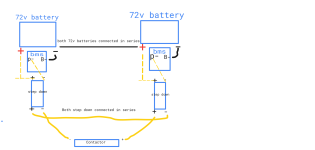maarkmohamed
100 W
- Joined
- Jan 10, 2019
- Messages
- 114
Hello, would greatly appreciate help with my circuit that I have in mind. The objective of the circuit is to have two 72v batteries that are connected in series, both of which have a bms on them. Both bms will not be used for discharge and only for charging. Rather for discharge safety I have a dc contactor that I would like to be turned off if either of the bms triggers it to turn off. With this in mind I have attached a drawing of my current circuit. As mentioned there is two 72v batteries connected in series, then from each battery I take the negative from the bms and the positive and run it to a step down converter on both sides. From there I connected the step down converters in series so that i an left with one positive and one negative wire. The step down converter is set to 6v on each output. Therefore two of them in series makes 12v to turn on the contactor. If one bms turns off its not enough voltage to turn on the contactor. However the issue is, when I connected the 72v batteries in series, the step down converter capacitor blew up on the output side. From what I'm being told the reason for it blowing up is because the step down isn't isolated from input to output. That being said anyone have a good solution for this? Sorry for the long write up. I really appreciate the help.
Sorry for the long write up. I really appreciate the help.
 Sorry for the long write up. I really appreciate the help.
Sorry for the long write up. I really appreciate the help.
